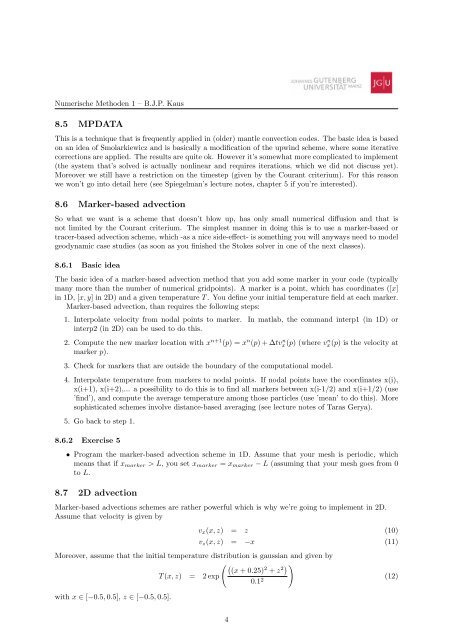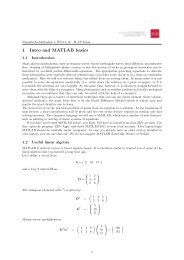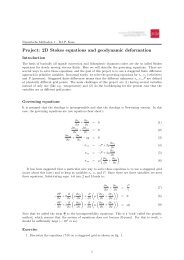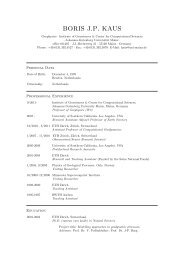8 Advection equations and the art of numerical modeling
8 Advection equations and the art of numerical modeling
8 Advection equations and the art of numerical modeling
- No tags were found...
You also want an ePaper? Increase the reach of your titles
YUMPU automatically turns print PDFs into web optimized ePapers that Google loves.
Numerische Methoden 1 – B.J.P. Kaus8.5 MPDATAThis is a technique that is frequently applied in (older) mantle convection codes. The basic idea is basedon an idea <strong>of</strong> Smolarkiewicz <strong>and</strong> is basically a modification <strong>of</strong> <strong>the</strong> upwind scheme, where some iterativecorrections are applied. The results are quite ok. However it’s somewhat more complicated to implement(<strong>the</strong> system that’s solved is actually nonlinear <strong>and</strong> requires iterations, which we did not discuss yet).Moreover we still have a restriction on <strong>the</strong> timestep (given by <strong>the</strong> Courant criterium). For this reasonwe won’t go into detail here (see Spiegelman’s lecture notes, chapter 5 if you’re interested).8.6 Marker-based advectionSo what we want is a scheme that doesn’t blow up, has only small <strong>numerical</strong> diffusion <strong>and</strong> that isnot limited by <strong>the</strong> Courant criterium. The simplest manner in doing this is to use a marker-based ortracer-based advection scheme, which -as a nice side-effect- is something you will anyways need to modelgeodynamic case studies (as soon as you finished <strong>the</strong> Stokes solver in one <strong>of</strong> <strong>the</strong> next classes).8.6.1 Basic ideaThe basic idea <strong>of</strong> a marker-based advection method that you add some marker in your code (typicallymany more than <strong>the</strong> number <strong>of</strong> <strong>numerical</strong> gridpoints). A marker is a point, which has coordinates ([x]in 1D, [x, y] in 2D) <strong>and</strong> a given temperature T . You define your initial temperature field at each marker.Marker-based advection, than requires <strong>the</strong> following steps:1. Interpolate velocity from nodal points to marker. In matlab, <strong>the</strong> comm<strong>and</strong> interp1 (in 1D) orinterp2 (in 2D) can be used to do this.2. Compute <strong>the</strong> new marker location with x n+1 (p) = x n (p) + ∆tv n x (p) (where v n x (p) is <strong>the</strong> velocity atmarker p).3. Check for markers that are outside <strong>the</strong> boundary <strong>of</strong> <strong>the</strong> computational model.4. Interpolate temperature from markers to nodal points. If nodal points have <strong>the</strong> coordinates x(i),x(i+1), x(i+2),... a possibility to do this is to find all markers between x(i-1/2) <strong>and</strong> x(i+1/2) (use’find’), <strong>and</strong> compute <strong>the</strong> average temperature among those p<strong>art</strong>icles (use ’mean’ to do this). Moresophisticated schemes involve distance-based averaging (see lecture notes <strong>of</strong> Taras Gerya).5. Go back to step 1.8.6.2 Exercise 5• Program <strong>the</strong> marker-based advection scheme in 1D. Assume that your mesh is periodic, whichmeans that if x marker > L, you set x marker = x marker − L (assuming that your mesh goes from 0to L.8.7 2D advectionMarker-based advections schemes are ra<strong>the</strong>r powerful which is why we’re going to implement in 2D.Assume that velocity is given byv x (x, z) = z (10)v z (x, z) = −x (11)Moreover, assume that <strong>the</strong> initial temperature distribution is gaussian <strong>and</strong> given by(((x + 0.25) 2 + z 2) )T (x, z) = 2 exp0.1 2with x ∈ [−0.5, 0.5], z ∈ [−0.5, 0.5].(12)4






